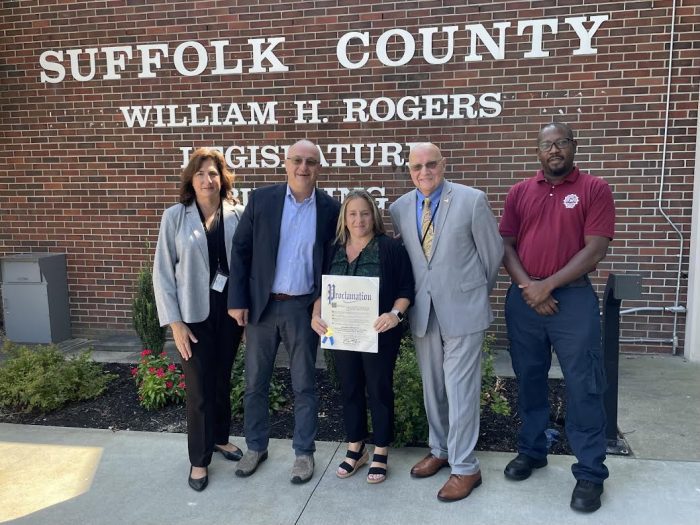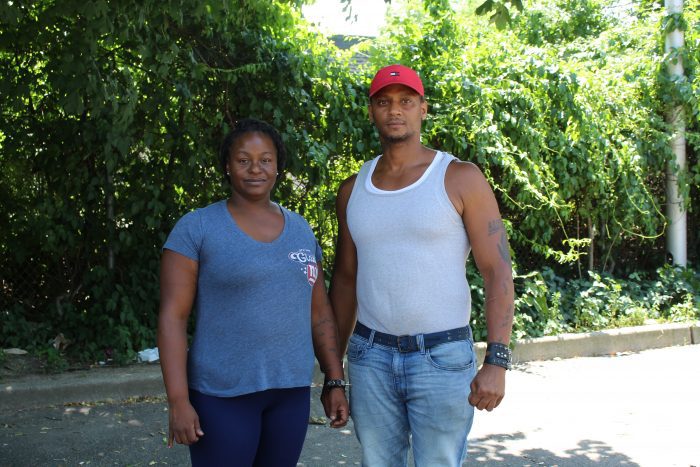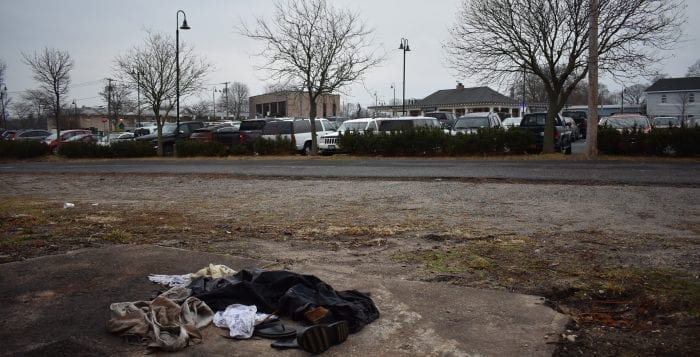After serving out a 17-year state prison sentence, Devon Toney returned to society unprepared for the challenges ahead.
Toney described parole as just another pressurized situation in a string of high-pressure environments that he has experienced since childhood. Parole, he said, only aggravated his post-traumatic stress disorder, stymying any opportunities for upward growth.
He soon entered the shelter system in Suffolk County, traveling between homeless shelters and health care facilities, his most recent stay at The Linkage Center in Huntington. Eventually, feeling suffocated in the shelters and unable to sleep among strangers, he left that system for a life on the streets. By night, he slept in train stations, bus stations, dugouts and public parks. By day, he stole, often reselling juices and water just to get by.
Without adequate resources and a lack of attention, Toney said those experiencing homelessness “have to steal,” that life on the streets “causes clean people — healthy people — to become addicts because that’s all they’re around.”
Toney remains homeless to the present day, currently residing near Ross Memorial Park in Brentwood. His story is one of countless examples of how easily one can become homeless after giving up on shelter, falling through the cracks with few opportunities to rise above these dire circumstances.
‘It’s probably one of the most difficult and complex moral and legal issues that I deal with.’
— Jonathan Kornreich
A startling trend
Mike Giuffrida, associate director of the Long Island Coalition for the Homeless, a nonprofit that works throughout Long Island to determine better strategies and policies to address homelessness, said he has noticed a recent trend of others fleeing from shelters.
“Although emergency shelter is available to the majority of people who present as having nowhere else to go, we are seeing an increased rate of individuals who are presenting as unsheltered and are living on the street,” he said.
Motivating this shelter shock, Giuffrida sees two principal factors: “The greatest commonality of people that experience homelessness is … significant trauma, likely throughout the majority — if not all — of their lives,” he said. The second factor is the structure of the shelter system, which is constrained by strict guidelines from New York State and “can be retraumatizing for people or the shelter settings do not meet their needs.”
An aversion to communal living is commonplace among those requesting emergency shelter. In addition, occupants of these shelters are often asked to give up considerable portions of their income for shelter payments. “They pay, in some cases, almost all of their income in order to stay in that undesirable location,” Giuffrida said.
Clusters of homeless encampments can be found in areas throughout Suffolk County. Brookhaven Town Councilmember Jonathan Kornreich (D-Stony Brook) says there are likely dozens of individuals experiencing homelessness in his council district alone, concentrated primarily in Port Jefferson Station.
Kornreich complained about how he is limited in his capacity to help, saying he wishes that he could do more. “It’s probably one of the most difficult and complex moral and legal issues that I deal with,” he said. “The Town of Brookhaven doesn’t have any functions with respect to social services or enforcement, but because this is an area of concern to me, I try to identify people who might be in need of services and try to either talk to people myself or put them in touch with services.”
Those services are provided through the Suffolk County Department of Social Services. In an emailed statement, a spokesperson affiliated with DSS outlined the array of options that are available through the department.
“The Suffolk County Department of Social Services offers temporary housing assistance, in shelter settings, to eligible individuals and families experiencing homelessness,” the spokesperson said. “We contract with nonprofit agencies that provide case management services to each client based on their individual needs, with a focus on housing support. Services may include referrals to community agencies, mental health programs, as well as medical services. These services, with the support and encouragement of shelter staff, work in concert to transition those experiencing homelessness to appropriate permanent housing resources.”
In an interview, County Executive Steve Bellone (D) said the COVID-19 pandemic and nationwide economic challenges have only exacerbated the conditions of homelessness throughout the county. Despite external barriers, he holds that there is room for improvement.
“More could always be done, of course,” he said. “We are — as I’ve said many times before — coming out of COVID and grappling with impacts and effects that we’re going to be dealing with for years to come and that we don’t fully understand yet.” He added, “The Department of Social Services has, throughout COVID, and as we’ve started to move out of that now, worked very hard to fulfill its mission and will continue to do that.”
‘The frustrating part is that we are limited… We are limited in forcing a person to get medical treatment.’
— Sarah Anker
Accepting services: A two-way street
Suffolk County Legislator Sarah Anker (D-Mount Sinai) detailed the decades-long history of homelessness in Coram. She argues that it is closely tied to other pressing matters facing county government: public safety, access to health care, the opioid epidemic and inadequate compensation for social workers.
The county legislator also blamed stringent state guidelines that handicap DSS’s outreach efforts. “The frustrating part is that we are limited,” Anker said. “We are limited in forcing a person to get medical treatment.”
Legislator Nick Caracappa (C-Selden), the majority leader of the county Legislature, voiced similar frustrations. He said he is concerned by the growing number of people that reject services from DSS.
“Even though you offer them help, you offer them shelter, and you offer them medical [assistance], they often turn it down,” he said. “They’d rather be out in the cold, alone, in the dark — whatever it is — than seek help. And that’s concerning.”
Emily Murphy, a licensed social worker who wrote a thesis paper investigating homelessness in Port Jefferson Station, said another significant problem is the lack of assistance for undocumented immigrants, whose immigration status bars them from applying for services.
“It’s not a DSS decision, but it comes from higher up, that if you don’t have documentation you can’t receive SNAP [Supplemental Nutrition Assistance Program] benefits or shelter,” Murphy said.
This changes during the colder months, according to Murphy, as shelters open their doors to all. Murphy also observed how a lack of political mobilization hampers the homeless community from receiving adequate government representation.
“That was the main thing,” Murphy said, referring to the homeless population. “It was a voice that was so often unheard and unlistened to.”
The gradual downward slope
Joel Blau, professor emeritus of the School of Social Welfare at Stony Brook University, has followed trends in homelessness for decades. He attributes rising homelessness in the United States since the 1970s to the stagnation of wages across that time frame coupled with the rising cost of housing.
“The notion of somebody with a high school education maintaining a decent standard of living is becoming ever more elusive,” he said. “Housing prices, particularly in cities, have escalated a lot, so unless you have two professionals in the family or one person who makes a lot of money, it’s increasingly difficult to get decent housing.”
Today, a growing number of people are just one step away from losing their homes. “Whether it be an accident or an illness or the loss of a job, all of a sudden they’re plummeting downward and onto the street,” he said.
Evaluating long-term projections of homelessness, Blau said there have been “periods where it plateaus and periods where it gets worse.” On the whole, he said, “the general trend is downward.”
Blau believes the way to remedy the issue is to change the ways in which society is organized. “It would require social housing, decommodifying it so that housing is a right, not something sold for profit,” he said. “And that’s probably, under the present political circumstances, a bridge too far.” In other words, problems associated with homelessness in this country have grown for many years and are likely to continue.
‘We need to let them know that we love and we care about them.’ — Devon Toney
Resurrection: A reason to hope
Toney has partnered with Latoya Bazmore, also of Brentwood, to create A.I.N.T. (All Included ’N’ Treated), a grassroots organization to combat homelessness in the community.
Toney said his primary goal is to access adequate housing. After that, he intends to galvanize his peers in the community, serving as a beacon for those who are also going through the struggle of homelessness. As someone who has experienced homelessness firsthand and who can relate to the plight, Toney believes he is uniquely situated to be an agent of change and a force of good.
“I need to be the one that interacts with these gang members, these addicts … they need somebody to articulate things to them,” he said. “We need to comfort them. We need to let them know that we love and we care about them.”
To learn more about the A.I.N.T. project, please visit the AIN’T (all included N Treated) Facebook page or visit the group on Instagram: @all.included.and.treated.







